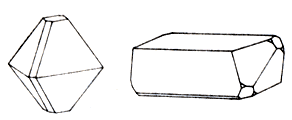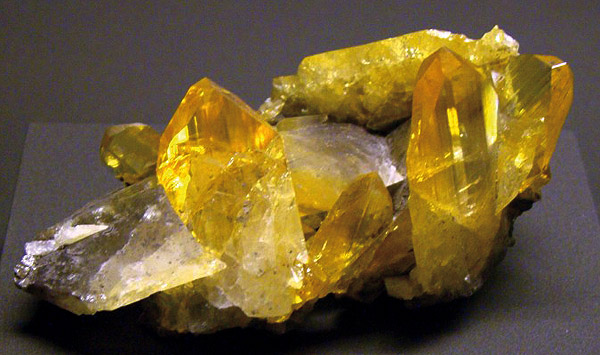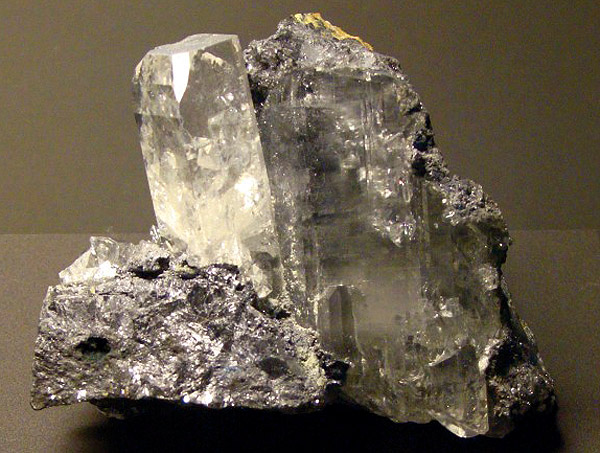Sulfates: Anglesey
 Diagnostic Card.
Diagnostic Card.
Anglesite forms are numerous: the crystal in the photo looks like a prism, topped pyramid.
Pb SO 4
Crystal system orthorhombic
Hardness 3
Specific gravity 6.3
Cleavage well observed along the base
fracture conchoidal
Colour colorless, differently colored
Color white powder
Diamond Gloss, with a tendency to fatty

As mineral first discovered on the island of Anglesey, the name of which is formed by name. Anglesite crystals, resembling the shape barite and celestite, very beautiful. They are mostly short and elongated prismatic, bipyramidal and sometimes very rich in faces; there are tabular. They always shine and sparkle like diamonds, due to its high refractive index, which is typical for other lead minerals. The crystals are colorless, transparent and translucent, but may have a variety of colors; especially appreciated the transparent green, purple and honey-yellow crystals. Sometimes there are white and opaque and even black difference due galena inclusions. Anglesey is not too hard; it is brittle and breaks easily at the cleavage; It has a lot of weight.
Chemical composition. Lead Oxide (PbO) 73.6% (68.3% lead), sulfur trioxide (SO3) 26,4%. Form crystals. Tabular, short-columnar, frequent small beautiful crystals with rich combinations of faces. The ratio of the axes. 1.571: 1: 1.288. The crystal structure. Anionic complex [SO4] 3- barite is similar to the same complex. Class symmetry. Rombo-bipyramidal - mmm. Cleavage. On the faces of the base and the prism (110), (001). Aggregates. Most often found in the form of finely crystalline crusts on galena, in cavities (drusen) in the form of a solid, grainy, earthy masses.
Diagnostic features.
Anglesite differs from cerussite poor solubility in dilute nitric acid. Barite, similar in shape, but not so heavy, with great difficulty, is melted in a candle flame, while anglesite legkoplavok. On a piece of charcoal he thus leaves a ball of lead metal. Easily melts, cracks; with soda on charcoal in the reducing flame gives wren lead. Dissolved in concentrated sulfuric acid by heating only, is completely dissolved in potassium hydroxide (KOH), different from barite, celestite, and which are not soluble.
Origin.
Anglesey - characteristic mineral deposits of lead oxidation zones, where it may come across quite often. Sometimes it occurs directly in pustotkah galena. In other cases it together with the strainer tserus-zinc and other minerals (such as smithsonite and hemimorphite) masses is in the limonite zone of sulfide oxidation.
Place of Birth.
Regions of the world where you can find spectacular crystals anglesite are many - among them the famous Tsumeb mine in Namibia and a number of places in Morocco. In Italy, known for the wonderful rare crystals of the two mines in Sardinia, today is not operating: Green found among galena in Montevecchio and colorless found in Monteponi. In general it noted that anglesite can be found, although in the form of fine crystals in many other places in Italy, where there is a lead-zinc orudinenie.
Application.
Although anglesite generally rare and does not form large deposits, it is used in admixture with other minerals, as component lead ores. It has scientific and collector value.

Anglesite. Twiss, Morocco. Photo: © AA Evseev.

Anglesite. Morocco. (2011).

Transparent crystals anglesite on galena. Morocco. (2011).

Anglesey (crystals) on galena. Morocco. (2011).
- Gatchell - "New Almadén snag" - arsenide and antimony sulfide (modern sulphosalts)
- Antimony - toxic metal (semi-metal) are widely used in industry, medicine and engineering
- Zirconium - a rare and non- metal and dangerous jewel in the oxide and salts
- Gold - yellow dangerous and toxic metal -date and accurate digital cable technology
- Sulphur - a golden-yellow toxic substance and a sign of volcanic activity
- Cadmium - a toxic uncirculated unknown wide range of people silvery metal
- Lead - a poisonous gray simulator silver metal and toxic metal snag
- Arsenic - poison classic medieval and modern poisoners and medicine in medicine
Toxic and hazardous radioactive rocks and minerals
** - Poisonous stones and minerals (obligatory check in chemical laboratory + clear indication of toxicity)
** - Radioactive rocks and minerals (obligatory check on a regular dosimeter + ban on the open sale of radioactivity in the event of more than 24 mR / hour + additional measures to protect the population)
Catalog minerals and gems in groups of the world
** - Poisonous stones and minerals
** - Radioactive rocks and minerals


Comments
Commenting, keep in mind that the content and the tone of your messages can hurt the feelings of real people, show respect and tolerance to his interlocutors, even if you do not share their opinion, your behavior in terms of freedom of speech and anonymity offered by the Internet, is changing not only virtual, but real world. All comments are hidden from the index, spam control.